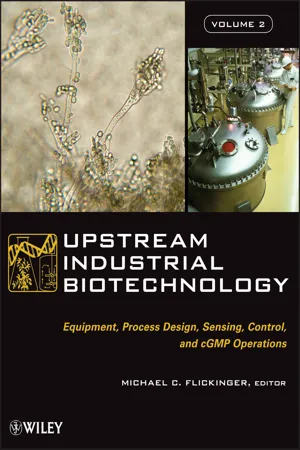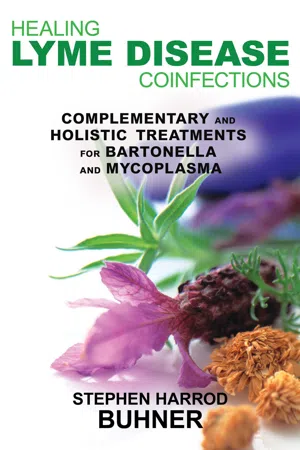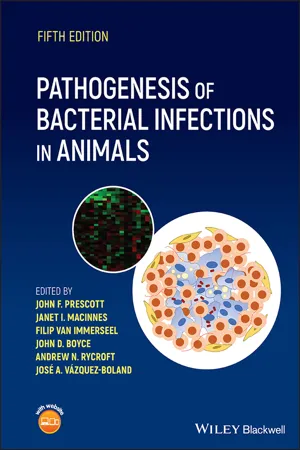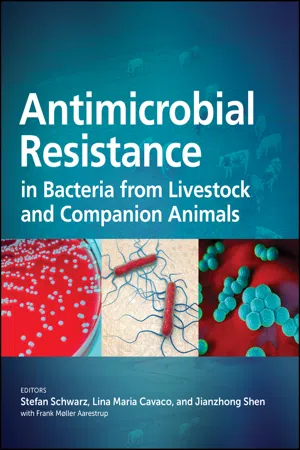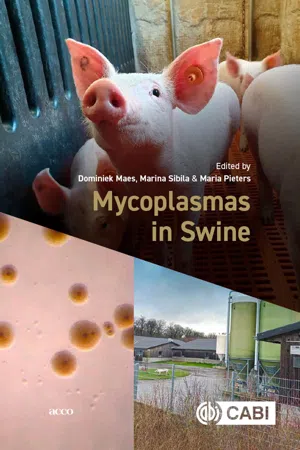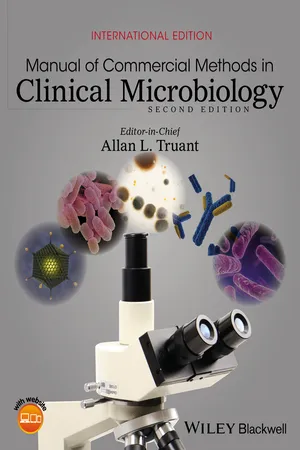Biological Sciences
Mycoplasma
Mycoplasma are a group of bacteria that lack a cell wall, making them unique among prokaryotes. They are the smallest free-living organisms and can cause various infections in humans and animals. Mycoplasma species are known for their ability to evade the immune system and for their resistance to many antibiotics, making them a significant concern in healthcare and veterinary settings.
Written by Perlego with AI-assistance
Related key terms
Related key terms
1 of 4
Related key terms
1 of 3
8 Key excerpts on "Mycoplasma"
- eBook - ePub
- Michael C. Flickinger(Author)
- 2013(Publication Date)
- Wiley(Publisher)
The contamination of cell cultures by Mycoplasmas remains one of the major problems encountered in biological research and biotechnology using cultured cells. Mycoplasmas can produce extensive changes and growth arrest in cultures they infect; the possible sequelae of contamination are legion. These organisms are resistant to many of the antibiotics that are in common use in cell cultures. This problem has become more widely appreciated since the introduction of sensitive, rapid, and efficient methods for the detection of cell culture Mycoplasmas. This chapter attempts to provide a concise review of the current knowledge on (1) the main characteristics and the taxonomy of Mycoplasmas; (2) the incidence and sources of Mycoplasma contamination in cell cultures, the Mycoplasma species most commonly detected in cell cultures, and the effects of Mycoplasmas on the function and activities of infected cell cultures; (3) the various techniques available for the detection of Mycoplasmas with particular emphasis on the most reliable detection methods; (4) the various methods available for the elimination of Mycoplasmas highlighting antibiotic treatment; and (5) the recommended procedures and working protocols for the detection, elimination, and prevention of Mycoplasma contamination. The availability of accurate, sensitive, and reliable detection methods and the application of robust and successful elimination methods provide a means for overcoming the insidious threat posed by Mycoplasma contamination of cell cultures.Mycoplasma; cell culture; contamination; detection; DAPI; agar; PCR; elimination; antibiotics22.1 Biology and Nomenclature of Mycoplasmas
22.1.1 Characteristics of Mycoplasmas
Mycoplasmas represent a large group of microorganisms that are characterized by their lack of a rigid cell wall, a standard attribute in all other types of bacteria. Therefore, a distinct class within the prokaryotes, appropriately named Mollicutes, was created. For historical and practical reasons, the trivial terms Mycoplasmas and mollicutes are often used as synonyms; first, prior to the introduction of the taxonomical term Mollicutes, the designation Mycoplasma had been generally employed for this class of organisms; secondly, the members of the subsequently established genus Mycoplasma are the most common and pathogenically most important organisms of this class with regard to human and animal infections and malignancies. Thus, the trivial term Mycoplasmas is still widely used in the broader sense and will be used here as well. The very first term for Mycoplasmas was “pleuropneumonia-like organisms” (PPLO), the causative agent of the primary atypical pneumonia. For specific details regarding the biology and taxonomy of Mycoplasmas, the reader is referred to specialist textbooks (1–3).Besides their lack of a cell wall, Mycoplasmas are (apart from the controversially discussed nanobacteria) considered to be the smallest self-replicating organisms known at present (Table 22.1 - eBook - ePub
Healing Lyme Disease Coinfections
Complementary and Holistic Treatments for Bartonella and Mycoplasma
- Stephen Harrod Buhner(Author)
- 2013(Publication Date)
- Healing Arts Press(Publisher)
It was only in the 1990s that researchers finally learned enough to begin to grow some of them in labs. Then in the 2000s extensive DNA research began to reveal their deeper natures. (This heightened research only occurred because it was accidently discovered that nearly all in vitro culture studies of most pathogenic bacteria had for decades been infected with Mycoplasmas, invalidating a lot of research.) As with Lyme and bartonella only in the decade around the millennium did the ability to really work with Mycoplasmas begin to take off and produce some deeper understandings of the organisms. (In spite of their relative newness to human understanding, there are already over 20,000 research papers on Mycoplasma organisms at PubMed, the free Internet research database. These chapters can only give an overview.)Because of the growth of DNA analysis, many bacteria that lack cell walls, most considered to be unrelated in the past, are now being included among the Mycoplasmas. In fact, they now have their own class—the Mollicutes—and their own family, Mycoplasmataceae.Mollicute means “soft skin” and refers to the lack of a cell wall while Mycoplasma itself, oddly, means “fungus formed.” An early researcher (1950s) thought the organism he was working with most resembled a fungus (myco ) and his name for it has, unfortunately, stuck. This often leads to some confusion among the general public; some people believe that the Mycoplasmas are fungoid in nature, not bacterial. Others confuse the Mycoplasma with another group of bacteria, the mycobacteria, among which is Mycobacterium tuberculosis . The Mycoplasmas and the mycobacteria are not related.There are now five orders in the Mollicute class, seven families, fourteen genera, and more than 200 different species. Most of the Mollicutes that cause human disease, with a few exceptions, are either Mycoplasma or Ureaplasma species. (The exceptions are Solobacterium moorei and Spiroplasma mirum .)Mycoplasmas are widely present throughout nature, infecting mammals, reptiles, fish, arthropods, and plants. There are a great many more than the 200 that have currently been identified. As Razin, Yogev, and Naot (1998, 1097) comment, the numbers of “mollicutes that have already been characterized and taxonomically defined constitute only a part, apparently a minor one, of the mollicutes living in nature.” All Mycoplasmas, irrespective of host, whether animal or plant, cause similar diseases. All of them are commonly (though not always) transmitted by insects. - eBook - ePub
- John F. Prescott, Janet I. MacInnes, Filip Van Immerseel, John D. Boyce, Andrew N. Rycroft, José A. Vázquez-Boland, John F. Prescott, Janet I. MacInnes, Filip Van Immerseel, John D. Boyce, Andrew N. Rycroft, José A. Vázquez-Boland(Authors)
- 2022(Publication Date)
- Wiley-Blackwell(Publisher)
31 MycoplasmasPollob K. Shil, Nadeeka K. Wawegama, Glenn F. Browning, Amir H. Noormohammadi, and Marc S. MarendaIntroduction
All members of the class Mollicutes are commonly referred to as Mycoplasmas. Each of the major domestic animal species is host to several different species of pathogenic Mycoplasmas, which typically cause chronic, endemic disease. Mycoplasmas lack a cell wall and have the smallest cell size (down to approximately 300 nm diameter) and the smallest genomes (down to 580 kb) of all free‐living organisms, a consequence of their reductive evolution from Gram‐positive bacteria with a low genomic G + C mol% content. They have a broad biological distribution as parasites of mammals, birds, reptiles, fish, cephalopods, crustaceans, arthropods, and plants. They are divided into four phylogenetic groups, Pneumoniae, Hominis, Anaeroplasma and Spiroplasma, but exhibit considerable genetic plasticity, with massive horizontal genetic transfer events between species in different phylogenetic groups shaping the evolution of a number of important pathogenic species. This is exemplified by the Mycoides cluster, a group of highly pathogenic species that only infect ruminants but lie within the Spiroplasma group, which is predominantly composed of insect‐transmitted plant pathogens. While the core genomes of the members of this cluster are most closely related to the spiroplasmas, approximately 20% of their genome is most closely related to the genomes of ruminant Mycoplasmas in the Hominis group. One member, Mycoplasma mycoides subspecies mycoides, causes contagious bovine pleuropneumonia (CBPP), one of the most important bacterial diseases of domestic animals.Characteristics of the Organisms
Mycoplasmas are obligate parasites and most survive on moist mucosal surfaces of their vertebrate hosts, although the hemophilic Mycoplasmas are exclusively parasites of erythrocytes. They are highly pleomorphic, but do have a cytoskeleton that controls their shape (Balish and Krause 2006 - Frank M. Aarestrup, Stefan Schwarz, Lina Maria Cavaco, Jianzhong Shen, Stefan Schwarz, Lina Maria Cavaco, Jianzhong Shen(Authors)
- 2018(Publication Date)
- ASM Press(Publisher)
20 Antimicrobial Resistance in Mycoplasma spp.Anne V. Gautier-Bouchardon1INTRODUCTION
Mycoplasmas belong to the phylum Firmicutes (Gram-positive bacteria with low G+C content), to the class Mollicutes (from Latin: mollis , soft; cutis , skin), to the order Mycoplasmatales , and to the family Mycoplasmataceae . They presumably evolved by degenerative evolution from Gram-positive bacteria and are phylogenetically most closely related to some clostridia. Mycoplasmas are the smallest self-replicating prokaryotes (diameter of approximately 0.2 to 0.3 μm) with the smallest genomes (500 to 1,000 genes). They are characterized by the lack of a cell wall. The Mycoplasma cell contains the minimum set of organelles essential for growth and replication: a plasma membrane, ribosomes, and a genome consisting of a double-stranded circular DNA molecule (1 ). The Mycoplasma genome is characterized by a low G+C content and by the use of the universal stop codon UGA as a tryptophan codon. As a result of their limited genetic information, Mycoplasmas express a small number of cell proteins and lack many enzymatic activities and metabolic pathways (1 ). Their nutritional requirements are therefore complex, and they are dependent on their host for many nutrients. This phenomenon explains the great difficulty of in vitro cultivation of Mycoplasmas, with complex media containing serum (as a source of fatty acids and cholesterol) and a metabolizable carbohydrate (as a source of energy, for example, glucose, arginine, or urea).All Mycoplasmas cultivated and identified so far are parasites of humans or animals (2 –5 ), with a high degree of host and tissue specificity. The primary habitats of Mycoplasmas are epithelial surfaces of the respiratory and urogenital tracts, serous membranes, and mammary glands in some animal species. Many Mycoplasma species are pathogens, causing various diseases and significant economic losses in livestock productions. Mycoplasmas have developed mechanisms to resist their hosts’ immune systems: modulatory effects on the host immune system, a highly plastic set of variable surface proteins responsible for rapid changes in major surface protein antigens (6 , 7 ) and invasion of nonphagocytic host cells (8 –11 ). These mechanisms contribute to the persistence of Mycoplasmas in their hosts and to the establishment of chronic infections. The main pathogenic species in humans and animals are listed in Table 1- eBook - ePub
- Dominiek Maes, Marina Sibila, Maria Pieters, Dominiek Maes, Marina Sibila, Maria Pieters(Authors)
- 2021(Publication Date)
- CAB International(Publisher)
CHAPTER 1OVERVIEW OF THE GENERAL CHARACTERISTICS AND CLASSIFICATION OF PORCINE Mycoplasma SPECIES
Andrew Rycroft11.1 Introduction
1.1.1 Characteristics of Mollicutes and Mycoplasmas
The bacteria which permanently lack cell wall peptidoglycan are placed in the class Mollicutes (Latin for soft skin). This is a distinct class of prokaryotes which includes genera such as Mycoplasma and Ureaplasma . They are free-living prokaryotes with small cells (0.2 – 0.4 μm) and are pleomorphic because they have no shape-defining cell wall. They also tend to produce very small colonies in culture. These bacteria carry a small genome (usually between 700 and 1000 kbp). This presumably confers only a relatively limited anabolic and catabolic ability compared to many bacteria. This may reflect the failure to acquire or evolve more functions or, alternatively, the loss of genetic capacity as the organism has degenerated to rely on its close association with the host.The first mollicute to be successfully cultured was Mycoplasma mycoides , the organism we now recognize as the causative agent of bovine pleuropneumonia. Later isolations of Mycoplasmas or other Mollicutes resembling M. mycoides were referred to as pleuropneumonia-like organisms or PPLO. This name was widely used but was gradually replaced by the term Mycoplasma for all bacteria of this type causing disease in humans and animals. The term Mollicutes was agreed for the entire class of organisms in 1967 but the word “Mycoplasma ” that in the correct sense only refers to the genus, still persists among biologists as the general or trivial term for these wall-less bacteria in many situations today.1.1.2 Phylogenetic relationships of Mycoplasmas
Until the advent of molecular (DNA-based) investigations, the classification of Mollicutes was reliant on culture-based characteristics and serology. Often growth requirements in culture were difficult to determine because successful culture usually requires animal serum. Since serum contains a wide variety of undefined chemicals and nutrients, it was usually not possible to recognize which components were essential requirements and which were not. The growth-inhibition test became widely established as the method of choice for recognition and classification of Mollicutes - Grace R. Carter, John R. Cole Jr.(Authors)
- 2012(Publication Date)
- Academic Press(Publisher)
27Mycoplasmas of Animals
Ole H.V. StalheimPublisher Summary
This chapter focuses on the Mycoplasmas of animals. The Mycoplasmas, which are members of the class Mollicutes and the order Mycoplasmatales, are the smallest free-living organisms. Unlike bacteria, they have no cell wall but are bounded by a membrane. This explains their remarkable pleomorphism. Most of the Mycoplasmas require sterol for growth. The chapter presents the taxonomy of class Mollicutes. Clinical observations, laboratory studies, and the results of controlled research have demonstrated causal relationships to disease for several Mycoplasmas. Pathogenic Mycoplasmas have a predilection for serous surfaces—such as the thoracic, abdominal, and articular cavities of cattle and swine and the air sacs of poultry—where they localize and persist protected from antibody and therapeutic agents by the fibrinous tissue reactions that characterize mycoplasmosis. They cause pneumonia, arthritis, and serositis in swine and mastitis, arthritis, and pneumonia in cattle, sheep, and goats. The significance of Mycoplasmas in diseases of the genital tract is not clear. The clinical signs of mycoplasmosis are not distinctive. The isolation and further cultivation for the identification of most Mycoplasmas from clinical materials is not difficult if a suitable, well-prepared medium is used. The chapter further reviews the laboratory procedures and isolation techniques employed for Mycoplasmas.The Mycoplasmas (members of the class Mollicutes, order Mycoplasmatales) are the smallest free-living organisms. Unlike bacteria, they have no cell wall but are bounded by a membrane. This explains their remarkable pleomorphism. In stained smears, they are seen as ring forms, globules, small coccobacilli, of filaments. Although the “fried egg” colony is the hallmark, a high percentage grow with aberrant colonial morphology when first isolated or grow as tiny colonies (T Mycoplasmas or ureaplasmas) visible only under the low power microscope (Fig. 27-1- (Author)
- 2016(Publication Date)
- Wiley-Blackwell(Publisher)
CHAPTER 12 MycoplasmaKen B. Waites1and CécileBébéar21 University of Alabama at Birmingham, Birmingham, AL, USA2 Université de Bordeaux, Bordeaux, France12.1 Introduction and clinical considerations
12.1.1 Mycoplasmas and ureaplasmas as human pathogens
Mycoplasmas and ureaplasmas are the smallest free-living microorganisms. Their simplicity is reflected by their fastidious nature and complex cultivation requirements. They demand special techniques for their laboratory detection and characterization that are often not available in hospital microbiology laboratories. Their fastidious nature and lack of appreciation for their importance as human pathogens has led to them being ignored by many diagnostic laboratories. This situation has changed somewhat in recent years because of greater appreciation for their clinical importance, improved methods for detection, including nonculture-based molecular assays such as polymerase chain reaction (PCR), availability of commercially manufactured growth media, serological assays, and products sold as complete diagnostic kits. However, the number and types of products available for detection and characterization of Mycoplasmas is still very limited in comparison to products sold commercially for other types of bacteria. A number of products available for use in Mycoplasma detection and characterization have never been subjected to rigorous external evaluation so that recommendations for their use cannot be made based on objective evidence of performance.Readers interested in an in-depth discussion of the taxonomy, disease associations, and biological characteristics of Mycoplasmas and ureaplasmas of humans are referred to other reference texts [50] for more detailed information on these aspects of human Mycoplasmas. Only a brief synopsis of this information is included here.Class Mollicutes (“soft skin”), includes the bacteria commonly referred to as Mycoplasmas (“fungus-form”). The class is comprised of four orders, five families, eight genera, and about 200 known species. Sixteen species have been isolated from humans, excluding occasional animal Mycoplasmas that have been detected in humans from time to time, but are generally considered transient colonizers. Mollicutes- eBook - ePub
- (Author)
- 2013(Publication Date)
- Wiley-Blackwell(Publisher)
Chapter 21
Mycoplasmosis
Introduction
Naola Ferguson-NoelMycoplasmas (class Mollicutes) are found in humans, many animal species, plants, and insects. These prokaryotes are characterized by their very small size, small genome, and complete absence of cell walls; they are bound by a plasma membrane only (26). This accounts for the “fried egg” type of colony morphology, resistance to antibiotics that affect cell wall synthesis, and complex nutritional requirements. Mycoplasmas tend to be quite host-specific; some infect only a single species of animal, whereas others may have the ability to infect several different host species. In general, Mycoplasmas colonize mucosal surfaces and most species are noninvasive. However, some species, including Mycoplasma gallisepticum (33) and M. synoviae (11), are known to have the ability to penetrate cells.Characterization
Mycoplasma species from avian sources generally require a protein-rich medium containing 10%–15% added animal serum. Further supplementation with some yeast-derived component is often beneficial. Growth of M. synoviae requires the addition of nicotinamide adenine dinucleotide (NAD) (see M. synoviae section). A medium described by Frey (16) or a medium described by Bradbury (2) is commonly used for the cultivation of avian Mycoplasmas.Mycoplasma organisms tend to grow rather slowly, usually prefer 37°C–38°C, and are rather resistant to thallium acetate and penicillin, which are frequently employed in media to retard growth of contaminant bacteria and fungi. Colonies form on agar media after 3–10 days at 37°C; however, nonpathogenic species such as M. gallinarum and M. gallinaceum may develop colonies within 1 day (M. gallinarum and M. gallinaceum are frequently isolated as contaminants during attempts to isolate pathogenic avian Mycoplasmas). Typical colonies are small (0.1–1 mm), smooth, circular, and somewhat flat with a denser central elevation (Figure 21.1
Index pages curate the most relevant extracts from our library of academic textbooks. They’ve been created using an in-house natural language model (NLM), each adding context and meaning to key research topics.
Explore more topic indexes
Explore more topic indexes
1 of 6
Explore more topic indexes
1 of 4
